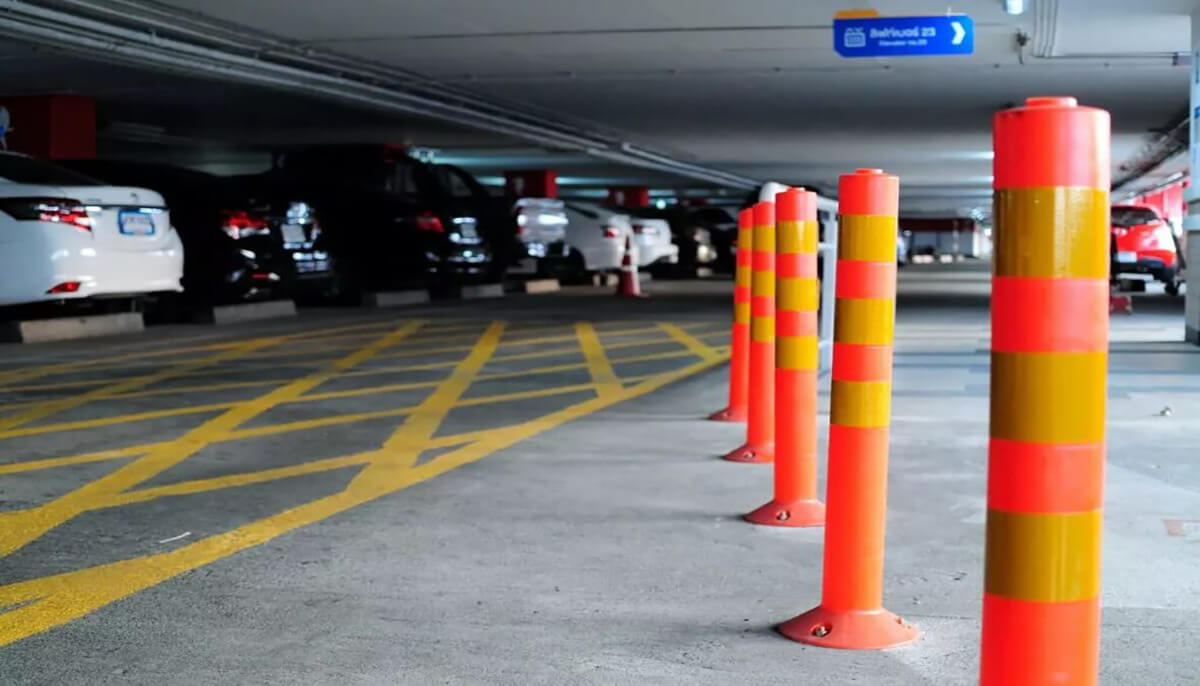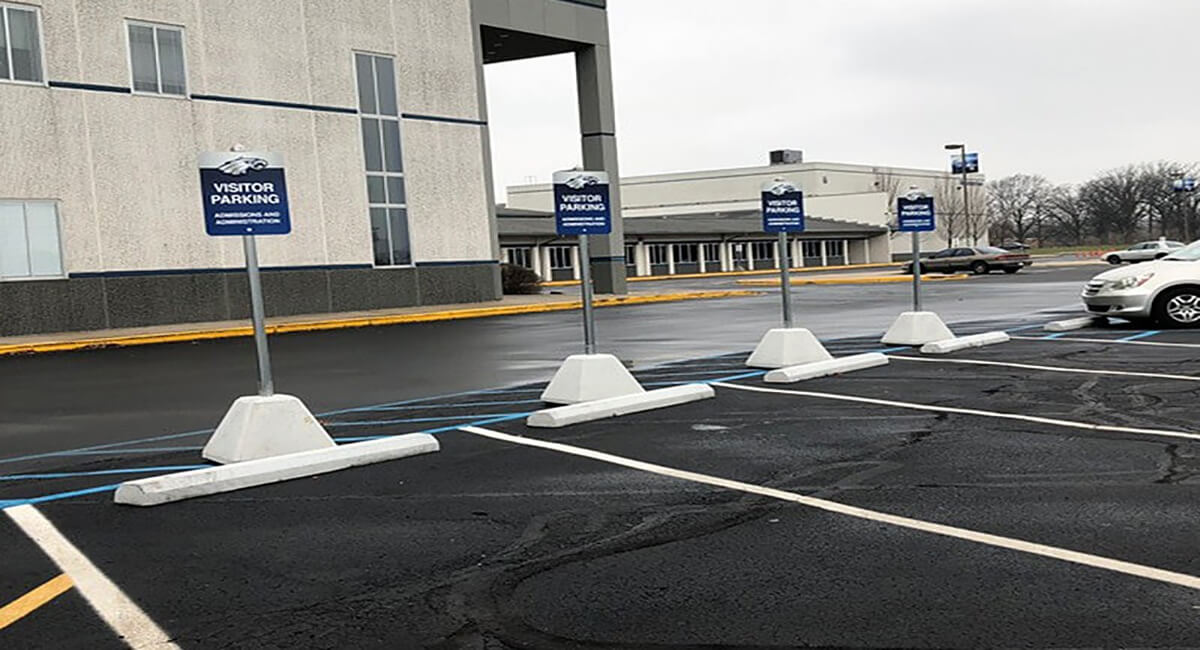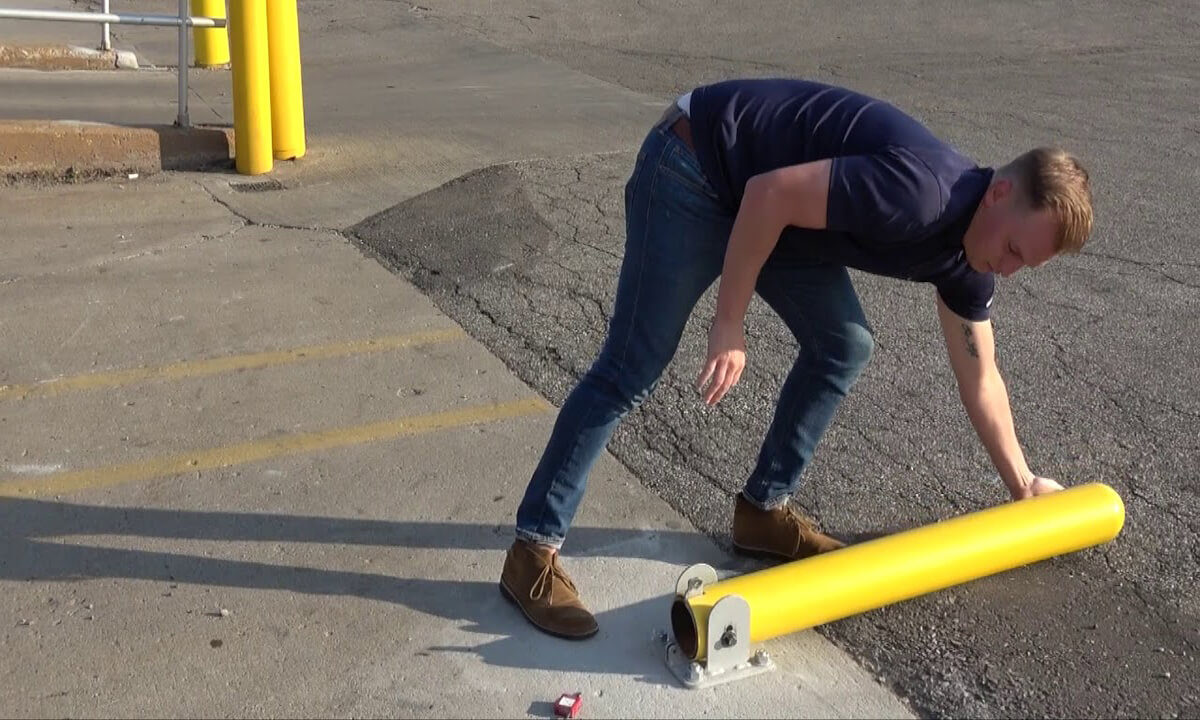Bollards act as a physical barrier between pedestrians, buildings, and vehicles in parking lots. Bollards are a useful way of allocating parking spaces and directing traffic. Before installing any parking bollards in your parking lot, there are a few things you should consider.
1. What Type of Parking Bollards I Should Install?
You should first determine what type of parking bollard you want to install. There are many different types, including fixed, retractable (or fold-down), and removable bollards. It depends on what you are using the bollard for and what desired outcome you are trying to achieve.
These types of parking-bollards include manual folding parking bollards, automatic remote bollards, and smartphone bollards. The cost will also play a decisive factor in your decision. Depending on the size and scope of the job, you may wish to speak with a parking professional who can advise you on the best options.
- Retractable or collapsible parking bollards offer the ability to implement flexible traffic flow management as they can be raised and lowered as required. Additionally, collapsible bollards can be used to reserve parking spaces for authorized drivers. When a driver leaves the space, you put up the parking bollard and it secures the space for that person until they return.
- When not in use, the removable bollards are easily removed, making them a practical choice for transient events.
- Fixed bollards are permanently installed primarily to prevent damage to building assets, and to separate pedestrian areas from vehicular areas.

2. What Regulations Should be Followed when Installing Parking Bollards?
When installing parking bollards, it is important to ensure that you comply with any building codes or standards. This is to meet minimum security requirements. For example, for fire doors, security bollards need to allow access for people leaving in a hurry in an emergency and also allow wheelchair access.
There is also an Australian Standard that deals with parking – AS2890. While it doesn’t directly address parking bollards, you need to consider factors such as visibility, whether they are a tripping hazard, whether they are made of suitably strong materials, and making sure they don’t block emergency exits. Occupational Health and Safety (OH&S) regulations take these issues into account.
The Building Code of Australia (BCA) also has certain requirements for embedded services in the slabs of tall buildings. For example. Water pipes, electrical conduits or anything else embedded in the concrete needs to be at least 50mm below the surface. Therefore, it is important to make sure not to drill too deep when installing parking bollards.
You don’t want to run a significant risk that if you drill too deep, you could run into these services and cause all sorts of problems. You don’t want to hit a water pipe that could spray all over the place and cause damage. or gas lines, so you end up with a gas leak in the building. Also, you don’t want to hit any cables, which could both injure you and cut power to the building. All of this is dangerous and expensive for the restoration of the building.
It is also wise, if possible, to request blueprints or architectural drawings that should show where embedded services are installed on the slab. For extra safety, some larger buildings employ consultants to do flatbed scans. This involves scanning concrete floors to identify the location of any embedded services. Another service in Australia is called Dial-before-you-dig. While helpful, it’s not always completely accurate because the service relies on contractors submitting where they provide their services.
3. Does the Installation of Parking Bollards Require Permission?
Yes. In strata buildings, you must always get approval from the building — whether it’s the owners association or the strata manager — before installing the parking bollards. Some buildings may have a pre-approval process, but you should always check before diving into the public property slab. If you need help seeking approval for a property or owner’s corporation, please let us know and we can send you an approval request form.
Some buildings impose additional standards on parking bollards. For example, they might want them installed by the same contractor, both within the same distance of a parking lot, or both to be the same model. Therefore, you will want to check with your building or strata to see if there are any additional requirements before installing a parking bollard.

4. Is It Difficult to Install the Parking Bollards?
Installing a parking bollard can be very simple or a little more complicated. It depends on the type of parking bollard you are installing, and the surface you are installing it on. The easiest level is to install surface-mounted parking bollards on a concrete slab. But there’s a lot more you need to consider when you’re installing inground bollards.
Always make sure you hire an expert who has installed parking bollards like we at aotons.com. Otherwise, if you’re confident enough with your tools to follow our detailed instructions for DIY installation, it’s also a good choice.
5. Who Can Install Parking Bollards?
At aotons.com we provide installation services for parking bollards across Australia. With 14 years of experience in the industry, we know it all. You can also install surface-mounted parking bollards yourself, if you have the right tools, you can follow our easy installation instructions. This works on concrete or asphalt surfaces. Or, if you have a local handyman they can easily install it for you by following our instructions.
If you want to install underground parking bollards, we strongly recommend that you hire a professional to do it, as it is much more complicated. You can also ask us for a quote for your underground installation.
6. How to Install the Parking Bollard?
Here are frequently asked questions on how to install a parking bollard.
1) Ready to Install Parking Bollards
You are now happy to install your brand new aotons.com parking bollard that will solve all your parking problems. But before you start drilling, you should take the following preparatory steps.

2) What tools are needed to install parking Bollards?
A hammer drill, masonry drill bits, concrete anchors or anchors, and quick-drying chemical epoxy are all the tools needed for installation. If you don’t already have these, you can rent them from a hardware store or hire a specialist to install parking bollards for you.
3) What fixtures do I use to install the parking bollards?
The fixtures needed to install a parking bollard depend on whether it is being installed on a concrete or asphalt surface. At aotons.com we supply the proper concrete fixings for all parking bollards – 10mm hex top Phillips screws. To install into asphalt, you can use head screws or an endless thread cut into the appropriate length.
4) Ground Mounted Parking Bollards vs. Underground Parking Bollards
The parking piles can be installed on the ground or drilled underground. Parking spaces in multi-story buildings and car parks prefer surface-mounted bollards because they interfere less with concrete slabs. In most covered parking basements, this is more than enough. The surface installation method is very simple and easy.
At aotons.com, all of our parking-bollards are surface mounted. There are several reasons for this. First, it makes it easy for you or your handyman to install it yourself. Secondly, this is very important in multi-story buildings to ensure that the installation complies with BCA regulations. Stratified buildings and commercial buildings always ask questions as they want to have as little penetration as possible into the concrete slab.
The underground installation is more complicated and requires professionals to operate. It usually requires core drilling and you need to go deep into the slab, so you need to be careful with embedded services.
5) How Far Apart Should the Parking Bollards Be?
Planning out where your bollards will be positioned relative to parking spaces or other bollards is critical for two reasons. First of all, professionalism and aesthetics are the most important. Drivers approach bollards neatly placed in parking spaces to be visually appealing.
Second, depending on how you use your bollards, you may have some compliance issues to consider. For example, bollards lined up to separate people from vehicles must have sufficient spacing to allow wheelchair users to pass through them. You must measure and specify the optimal location of your bollards relative to the parking space to ensure proper bollard spacing.
6) Check for Any Embedded Services
As mentioned above, it’s important to make sure you don’t drill holes in the slab and hit any water, gas, or electrical lines. So make sure you only drill 50mm deep into the slab. For extra precaution, you may also wish to perform a flatbed scan and/or a Dial.

7) Clean and Flatten the Surface
The surface on which the bollard will be installed is the next thing you should consider. Clean, flat, and in good condition. Installing into a block of old concrete or asphalt with holes is not ideal because there is less surface for the fixings to grab onto.
8) Check Your Site Location
Decide where you want to install the dollies in your parking space. We recommend installing parking bollards one-third of the way into the parking space, assuming it is a traditional parking space with simple entry and exit.
This is usually about 1000-1200mm from the open end of the parking space. At most, we’ll put the parking lock in the middle of the parking space. Sometimes people want to install them in slightly different positions, but if you are not sure, please call us and we will give you advice on the best position to place the parking bollards according to your needs.
It also matters whether your parking-bollards are installed indoors or outdoors. If installing parking bollards outdoors, you should choose weather-resistant parking bollards. Both concrete and steel are reliable materials for outdoor bollards. If you’re building bollards indoors, you’ll be more flexible in your material choices. Bollards made of both plastic and metal are popular materials for indoor installations.
9) Installing Parking Bollards to Concrete Surfaces
The process is simple if you’re installing surface-mounted parking bollards on a concrete surface. If you have a concrete drill and are confident with it, you can do the installation yourself.
For installing manual, automatic remote, and smartphone parking bollards, we recommend the following procedure. All of our bollards at aotons.com are surface mounted, making them suitable for a wider range of buildings as they are less invasive to concrete or asphalt surfaces. We supply concrete anchors for all parking barriers including manual, remote, and smartphone parking locks.
Each of our parking bollards has pre-drilled holes in the base plate. Each bollard has 3, 4, or 6 holes depending on the type you choose. Mark the predrilled holes with chalk or a marker before installing the bollard. Next, use a rotary hammer drill with an appropriately sized bit to drill the required number of holes to a depth of only 50mm.
Then mount the baseplate of the parking bollard over the drilled holes, insert Phillips screws into the tops of the baseplate holes, and drill them into the concrete. Tighten the end of the fixture if necessary. For manual parking bollards, you are now done. For automatic or remote-controlled parking bollards, you simply place the cover over the base plate and lock the housing. Ensure the hooks that lock it are installed correctly and you’re ready!
10) Can the Parking Bollard be Moved After Installation?
Yes, you can move the parking bollard to a different location. All you need to do is use a masonry drill with the appropriate hex bit, turn it upside down, and unscrew the screws from the base plate. It leaves small holes, but you can easily restore them to their original state. Just get a little epoxy filler from your local hardware put it in the hole and let it set.
Install your parking bollard at the new location in the same manner as you did the first time! It’s easy! Installing a parking bollard is a relatively simple and easy process. Whether you are confident enough to do it yourself or would like aotons.com to provide you with a professional installation quote, especially for high-volume orders, please contact us and ask for a quote.

7. Conclusion
This guide summarizes how to install a parking bollard and the common problems of installation. If you are installing a parking bollard for the first time, we recommend that you find a professional installer to operate it.





Leave A Comment